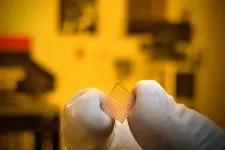(Press-News.org) A new study led by Winship Cancer Institute of Emory University and Abramson Cancer Center of University of Pennsylvania researchers demonstrates that a first-of-its-kind platform using artificial intelligence (AI) could help clinicians and patients assess whether and how much an individual patient may benefit from a particular therapy being tested in a clinical trial. This AI platform can help with making informed treatment decisions, understanding the expected benefits of novel therapies and planning future care.
The study, published in Nature Medicine, was led by board-certified medical oncologist Ravi B. Parikh, MD, MPP, medical director of the Data and Technology Applications Shared Resource at Winship Cancer Institute of Emory University and associate professor in the Department of Hematology and Medical Oncology at Emory University School of Medicine, who develops and integrates AI applications to improve the care of patients with cancer. Qi Long, PhD, a professor of Biostatistics, and Computer and Information Science, and founding director of the Center for Cancer Data Science at the University of Pennsylvania, and associate director for Quantitative Data Science of the Abramson Cancer Center of Penn Medicine, was co-senior author. The study’s first author was Xavier Orcutt, MD, a trainee in Parikh’s lab. Other study authors included Kan Chen, a PhD student training in Long’s lab, and Ronac Mamtani, associate professor of medicine at the University of Pennsylvania.
Parikh and his fellow researchers developed TrialTranslator, a machine learning framework to “translate” clinical trial results to real-world populations. By emulating 11 landmark cancer clinical trials using real-world data, they were able to recapitulate actual clinical trial findings, thus enabling them to identify which distinct groups of patients may respond well to treatments in a clinical trial, and those that may not.
“We hope that this AI platform will provide a framework to help doctors and patients decide if the results of a clinical trial can apply to individual patients,” Parikh says. “Furthermore, this study may help researchers identify subgroups in whom novel treatments do not work, spurring newer clinical trials for those high-risk groups.”
“Our work demonstrates the enormous potential of leveraging AI/ML to harness the power of rich, yet complex real-world data to advance precision medicine at its best,” adds Long.
Limited generalizability of trial results
Parikh explains that clinical trials of potential new treatments are limited because less than 10% of all patients with cancer participate in a clinical trial. This means clinical trials often do not represent all patients with that cancer. Even if a clinical trial shows a novel treatment strategy has better outcomes than the standard of care, “there are many patients in whom the novel treatment does not work,” Parikh says.
“This framework and our open-source calculators will allow patients and doctors to decide whether results from phase III clinical trials are applicable to individual patients with cancer,” he says, adding that “this study offers a platform to analyze the real-world generalizability of other randomized trials, including trials that have had negative results.”
How they did their analysis
Parikh and colleagues used a nationwide database of electronic health records (EHR) from Flatiron Health to emulate 11 landmark randomized controlled trials (studies that compare the effects of different treatments by randomly assigning participants to groups) that investigated anticancer regimens considered standard of care for the four most prevalent advanced solid malignancies in the United States: advanced non-small cell lung cancer, metastatic breast cancer, metastatic prostate cancer and metastatic colorectal cancer.
What they found
Their analysis revealed that patients with low- and medium-risk phenotypes, which are machine learning-based traits used to assess the underlying prognosis of a patient, had survival times and treatment-associated survival benefits similar to those who were observed in the randomized controlled trials. In contrast, those with high-risk phenotypes showed significantly lower survival times and treatment-associated survival benefits compared to the randomized controlled trials.
Their findings suggest that machine learning can identify groups of real-world patients in whom randomized controlled trial results are less generalizable. This means, they add, that “real-world patients likely have more heterogeneous prognoses than randomized controlled trial participants.”
Why this is important
The research team concludes that the study “suggests that patient prognosis, rather than eligibility criteria, better predicts survival and treatment benefit.” They recommend that prospective trials “should consider more sophisticated ways of evaluating patients’ prognosis upon entry, rather than relying solely on strict eligibility criteria.”
What’s more, they cite recommendations by the American Society of Clinical Oncology and Friends of Cancer Research that efforts should be made to improve the representation of high-risk subgroups in randomized controlled trials “considering that treatment effects for these individuals might differ from other participants.”
As to the role of AI in studies such as this one, Parikh says, “Soon, with appropriate oversight and evidence, there will be an increasing tide of AI-based biomarkers that can analyze pathology, radiology or electronic health record information to help predict whether patients will or will not respond to certain therapies, diagnose cancers earlier or result in better prognoses for our patients.”
This research was supported by grants from the National Institute of Health: K08CA263541, P30CA016520 and U01CA274576.
END
New AI platform identifies which patients are likely to benefit most from a clinical trial
'TrialTranslator' framework 'translates' clinical trial results to real-world populations
2025-01-08
ELSE PRESS RELEASES FROM THIS DATE:
Unique Stanford Medicine-designed AI predicts cancer prognoses, responses to treatment
2025-01-08
The melding of visual information (microscopic and X-ray images, CT and MRI scans, for example) with text (exam notes, communications between physicians of varying specialties) is a key component of cancer care. But while artificial intelligence helps doctors review images and home in on disease-associated anomalies like abnormally shaped cells, it’s been difficult to develop computerized models that can incorporate multiple types of data.
Now researchers at Stanford Medicine have developed an AI model able to incorporate visual ...
A new ultrathin conductor for nanoelectronics
2025-01-08
As computer chips continue to get smaller and more complex, the ultrathin metallic wires that carry electrical signals within these chips have become a weak link. Standard metal wires get worse at conducting electricity as they get thinner, ultimately limiting the size, efficiency, and performance of nanoscale electronics.
In a paper published Jan. 3 in Science, Stanford researchers show that niobium phosphide can conduct electricity better than copper in films that are only a few atoms thick. Moreover, these films can be created and deposited at sufficiently low temperatures to be compatible with modern computer ...
Synthetic chemicals and chemical products require a new regulatory and legal approach to safeguard children’s health
2025-01-08
Chestnut Hill, Mass (01/08/2025) – Nations must start testing and regulating chemicals and chemical products as closely as the current systems that safeguard prescription drugs or risk rising rates of chronic illnesses among children, according to a New England Journal of Medicine report by a group of experts writing as the Consortium for Children’s Environmental Health.
Global chemical inventories contain an estimated 350,000 products – such as manufactured chemicals, chemical ...
The genes that grow a healthy brain could fuel adult glioblastoma
2025-01-08
FOR IMMEDIATE RELEASE
Media Contact: Levi.Gadye@ucsf.edu, (415) 502-6397
Subscribe to UCSF News
The discovery of a new type of stem cell in the brain could usher in better treatments for the deadliest brain tumor.
UCSF scientists have discovered a stem cell in the young brain that’s capable of forming the cells found in tumors. The breakthrough could explain how adult brain cells take advantage of developmental processes to instigate the explosive growth seen in deadly brain cancers like glioblastoma.
They made the discovery while taking a broad genomic survey of human brain ...
New MSU study explains the delayed rise of plants, animals on land
2025-01-08
EAST LANSING, Mich. – If you like the smell of spring roses, the sounds of summer birdsong and the colors of fall foliage, you have the stabilization of the ozone layer to thank for it. Located in the stratosphere where it shields the Earth from harmful ultraviolet radiation, the ozone layer plays a key role in preserving the planet’s biodiversity.
Now, we may have a better idea of why that took more than 2 billion years to happen.
Michigan State University researcher Dalton Hardisty contributed to a new Yale University-led study finding that Earth’s early atmosphere hosted a battle royal between ...
UTA becomes one of largest natural history libraries
2025-01-08
Thanks to in-kind donations of tens of thousands of rare books, scientific journals, and articles, and reports over the past two years, The University of Texas at Arlington’s Amphibian and Reptile Diversity Research Center (ARDRC) has become one of the largest publicly accessible herpetology libraries in the world.
“Thanks to 12 independent donors, including the Joseph Rex Dinardo Jr. Herpetology and Natural History Science Research Trust in Philadelphia, Dr. Jonathan Campbell, William Lamar, Drs. Jay and Rebecca Savage, and Louis Porras, we now have thousands ...
Number of autistic individuals enrolled in Medicaid and receiving federal housing support increased by 70% from 2008-16
2025-01-08
Affordable and stable housing is critical to improving health across a person's lifespan. People with disabilities, including autism, comprise a significant share of people in need of housing assistance. However, the intersection of housing and health among individuals with autism is largely unknown because data on public housing and public health are not connected. Researchers from Drexel University’s A.J. Drexel Autism Institute examined how many autistic people in the United States received housing ...
St. Jude scientists create scalable solution for analyzing single-cell data
2025-01-08
Researchers have amassed vast single-cell gene expression databases to understand how the smallest details impact human biology. However, current analysis methods struggle with the large volume of data and, as a result, produce biased and contradictory findings. Scientists at St. Jude Children’s Research Hospital created a machine-learning algorithm capable of scaling with these single-cell data repositories to deliver more accurate results. The new method was published today in Cell Genomics.
Before single-cell analysis, bulk gene expression data ...
What is the average wait time to see a neurologist?
2025-01-08
MINNEAPOLIS – Older people wait an average of just over a month to see a neurologist for specialty care after being referred by their primary care physician or another physician, according to a study published in the January 8, 2025, online issue of Neurology®, the medical journal of the American Academy of Neurology. The study, which looked at people who have Medicare insurance, also found some people wait more than three months to see a neurologist.
“Neurologists provide important and ongoing care for people ...
Proximity effect: Method allows advanced materials to gain new property
2025-01-08
UNIVERSITY PARK, Pa. — Ferroelectrics are special materials with polarized positive and negative charges — like a magnet has north and south poles — that can be reversed when external electricity is applied. The materials will remain in these reversed states until more power is applied, making them useful for data storage and wireless communication applications.
Now, turning a non-ferroelectric material into one may be possible simply by stacking it with another ferroelectric material, according to a team led by scientists from Penn State who demonstrated the phenomenon, called proximity ferroelectricity.
The ...
LAST 30 PRESS RELEASES:
Air pollution exposure and birth weight
Obstructive sleep apnea risk and mental health conditions among older adults
How talking slows eye movements behind the wheel
The Ceramic Society of Japan’s Oxoate Ceramics Research Association launches new international book project
Heart-brain connection: international study reveals the role of the vagus nerve in keeping the heart young
Researchers identify Rb1 as a predictive biomarker for a new therapeutic strategy in some breast cancers
Survey reveals ethical gaps slowing AI adoption in pediatric surgery
Stimulant ADHD medications work differently than thought
AI overestimates how smart people are, according to HSE economists
HSE researchers create genome-wide map of quadruplexes
Scientists boost cell "powerhouses" to burn more calories
Automatic label checking: The missing step in making reliable medical AI
Low daily alcohol intake linked to 50% heightened mouth cancer risk in India
American Meteorological Society announces Rick Spinrad as 2026 President-Elect
Biomass-based carbon capture spotlighted in newly released global climate webinar recording
Illuminating invisible nano pollutants: advanced bioimaging tracks the full journey of emerging nanoscale contaminants in living systems
How does age affect recovery from spinal cord injury?
Novel AI tool offers prognosis for patients with head and neck cancer
Fathers’ microplastic exposure tied to their children’s metabolic problems
Research validates laboratory model for studying high-grade serous ovarian cancer
SIR 2026 delivers transformative breakthroughs in minimally invasive medicine to improve patient care
Stem Cell Reports most downloaded papers of 2025 highlight the breadth and impact of stem cell research
Oxford-led study estimates NHS spends around 3% of its primary and secondary care budget on the health impacts of heat and cold in England
A researcher’s long quest leads to a smart composite breakthrough
Urban wild bees act as “microbial sensors” of city health.
New study finds where you live affects recovery after a hip fracture
Forecasting the impact of fully automated vehicle adoption on US road traffic injuries
Alcohol-related hospitalizations from 2016 to 2022
Semaglutide and hospitalizations in patients with obesity and established cardiovascular disease
Researchers ‘listen in’ to embryo-mother interactions during implantation using a culture system replicating the womb lining
[Press-News.org] New AI platform identifies which patients are likely to benefit most from a clinical trial'TrialTranslator' framework 'translates' clinical trial results to real-world populations



